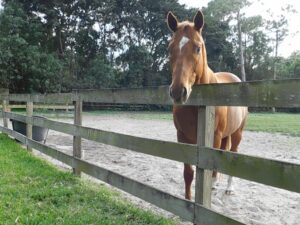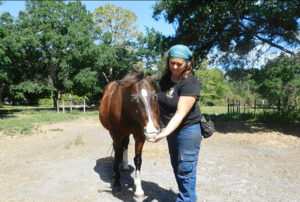Barks Blog
Developing Food Manners
By Michelle Martiya

One of the top reasons I believe people move away from clicker training with their horses is being unsure of how to manage their animal’s behavior around food. Horses can often become over-excited with the introduction of food reinforcers and offer unexpected or even dangerous behaviors that can scare or injure their handlers.
In my experience, “food manners” is often taught as an isolated behavior in which the horse stands calmly next to his handler, facing forward in a neutral position. While this behavior is an excellent default behavior to have, it should not be viewed as the whole of your equine’s food manners.
Food manners develop over time and are dependent on your clarity and consistency in the management and delivery of the food. In this video, Safely Hand Feed Your Horse, I address every issue that people encounter with hand feeding horses that I’ve heard of so far. You can also follow the guidelines below to help you be successful in introducing clicker training and food reinforcements to your horse:
Food Deprivation
In my experience, resource guarding and general anxiety around food is pretty common in horses and your horse may have pre-existing issues with food you don’t even know about. Even if your equine is getting plenty of food now, a history of deprivation can still cause considerable anxiety when you begin training with food reinforcers. Using a low-value food and having plenty of free food available during training can help to reduce this anxiety.
Practice without the Animal
An anxious handler may result in an anxious horse, so it’s important to feel comfortable with the mechanics of your food delivery before you begin. A treat pouch that’s comfortable to wear, easy to reach into and pull out a handful of food, and secure enough to not spill food everywhere when you crouch down or lean over is a must.
Consider where you are going to wear your treat pouch. This will depend on how you plan to feed and how your horse behaves when you begin the training. If you’re feeding underhand with the hand closest to your horse, then you’ll want your treat pouch on the inside hip. If you’re feeding overhand with the hand furthest away from the horse, then you’ll want it on the outside hip. Keep in mind that wearing the pouch on your front or on the hip closest to your horse may make it more difficult for your horse to ignore.

Timing
It takes considerable self-control to keep your body still while you click for behavior so it’s a good idea to practice this often. Click your clicker first and then move your hand to reach for the food in your pouch. Preloading your hand is also something to consider, as it will mean faster delivery of the reinforcer, but your hand should remain still holding the food until after you mark the behavior. Otherwise, the movement of your hand becomes the mark.
Protected Contact
Most people promote protected contact as a way to keep you safe from your horse, but there are many other reasons to begin training in protected contact and even to use it periodically throughout your training.
For your horse, protected contact eliminates the possibility of searching for food on you, allowing him to focus on the learning process. It also helps to reduce any anxiety he may feel in your presence and gives him the option of walking away without worrying about you following him.
For you, protected contact allows you to test out your food delivery mechanics and focus on marking the behaviors you want. If there are any issues, you can work them out without worrying about any of your horse’s undesirable behaviors.
Feed for Position
Where you feed your horse can make the difference between a horse that is searching for food on your person or nipping you, and one that is not. Feeding close to your body or right over the treat pouch can often encourage these behaviors. Feeding at arm’s length away from your body discourages them.
Sometimes when you click for a behavior, your horse may move before you have a chance to deliver the reinforcement. In these instances, delivering the food where you want your horse to be instead of where he is can help to further the desired behavior.
For example, if you clicked and your horse took a step forward towards you, you can place the food in such a way that it causes him to step back again to where he was when you clicked. Likewise, if your horse is standing with his head facing forward, but turned his head towards you when you clicked, you can feed where his head was when you clicked to bring him back into the position you want. Your horse will learn to wait for the food to come to him.
Rate of Reinforcement
You’ll hear many people say that when you start, you need to maintain a high rate of reinforcement to prevent frustration and mugging behaviors. This can be very misleading, however, as it implies that you should be stuffing your horse’s face no matter what.
What you really want to achieve is a high rate of success. Choosing attainable criteria will mean that your horse can be successful right away. For example, if your horse is a little bit shy, expecting him to reach out and touch a target on his first attempt may not be a reasonable expectation. For your horse to be successful, your initial criteria need to be somethings easier, like the horse reaching towards the target with his nose from three feet away. A few repetitions of this easily attainable criteria will result in a horse that quickly closes the distance and touches the target with his nose. Breaking down behaviors in this way will create a high rate of success which equals a high rate of reinforcement.
End of Session Signal
An end of session signal lets your horse know that the training session is over and opportunities for reinforcement are no longer available. To avoid creating a negative association with your departure, it can be helpful to leave an extra handful of food or an enrichment activity for your horse as you go.
While this is not a complete list of the many ways you can help develop your horse’s manners around food, hopefully it will get you started on the best path to success. Remember, every horse is different so don’t be afraid to try different things until you find what works best for you and your horse.
Resources
Essential Animal Training. (2019, November 18). Safely Hand Feed Your Horse [Video File]. Available at: https://youtu.be/ZMiE3Y8TeII
This article was first published in BARKS from the Guild, July 2020, pp.56-57. For more great content on all things animal behavior and training, you can sign up for a lifetime, free of charge, subscription to the digital edition of BARKS from the Guild. If you are already a subscriber, you can view the issue here.
About the Author
Michelle Martiya owns Essential Animal Training in Boca Raton, Florida where she offers training and behavior modification services, both in person and online. She specializes in working with wild mustangs and abused, fearful equines, be it horse, donkey/burro, or mule, as well as exotic pets, puppies and adult dogs.

